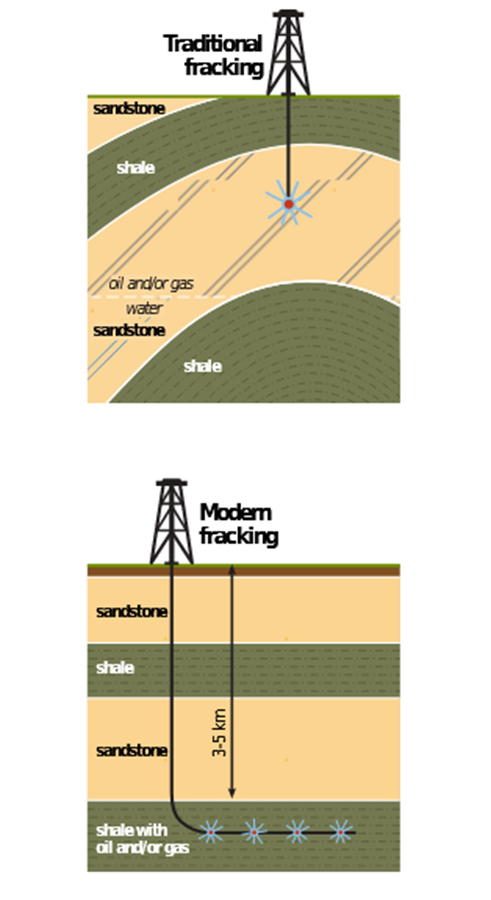Introduction
Fracking is a technique known as hydraulic fracturing that allows for drilling sand, ground, and rock to reach gas and oil reservoirs (Norris et al. 323). The process is based on using the high-pressure water to create open fractures and allow gas and oil to move into these fractures for the further production. This technique is critical to guarantee the effective extraction of gas and oil from reservoirs (Burton et al. 1680). However, the problem is that fluids used for fracking contain a lot of harmful additives, including antiscalants, solvents, and proppants among others, that are toxic and contaminate groundwater and soil (Norris et al. 335). Furthermore, there are also methane emissions and risks of explosions associated with the use of this technology.
The research question to be answered with the help of this study is the following one: What particular advantages or benefits, as well as disadvantages or negative consequences, of fracking exist and how do they influence the environment?
In this research, it is important to discuss advantages and disadvantages of fracking with the focus on consequences for the environment and suggest approaches to addressing negative effects of using this technology.
Methods
This descriptive study is based on the review and analysis of qualitative and quantitative data presented in the recent studies on fracking. The findings of studies conducted in 2014, 2016, and 2017 were reviewed to identify benefits of using modern hydraulic fracturing technologies in contrast to traditional ones. Furthermore, the results of studies were analyzed to determine significant consequences of fracking for the environment. The proposed recommendations to address the situation were examined, and the most effective approaches are described in this study.

Results
The review of the recent studies indicates that modern fracking is a beneficial technology for oil and gas production because of enabling professionals to create many fractures on wide territories and efficiently extract gas and oil. Modern fracking is high-volume, and it allows for a horizontal production with the help of directional drilling and making many hydraulic fractures (see fig. 1). Researchers discuss this technology as more efficient and productive than the traditional one (Norris et al. 323). Still, studies also indicate negative consequences of fracking for the environment. Fracking can potentially lead to:
- contaminating groundwater and soil with toxins;
- increased atmosphere emissions;
- increased seismicity;
- risks of explosions.
Thus, only about 20%-40% of the used water returns in fractures, and the large amount of fluid with additives contaminates groundwater (Norris et al. 330). Furthermore, in spite of possibilities to prevent more than 90% of methane emissions, the problem still exists contributing to the greenhouse effect. In addition, hydraulic fracturing can provoke earthquakes (Meng 954). Another risk is associated with the activity of mud volcanoes and explosions because of non-addressing safety norms.
Conclusion
The motivation for using fracking is the provision of more energy resources for people all over the globe. However, the problem is that this technology is potentially damaging to the environment. In order to address negative consequences of fracking, researchers propose the following strategies and steps:
- strategic replacement of using hydrocarbons with alternative sources of energy at the global arena;
- reduction of CO2 emissions and other atmosphere emissions with the help of limiting hydraulic fracturing procedures at the governmental level (Burton et al. 1683);
- reduction of using toxic chemicals as additives (Norris et al. 350);
- geographic information systems for controlling fracking should be created;
- improved regulatory requirements for hydraulic fracturing activities should be formulated (Meng 955).
Bibliography
Burton, Allen, et al. “Hydraulic “Fracking”: Are Surface Water Impacts an Ecological Concern?” Environmental Toxicology and Chemistry, vol. 33, no. 8, 2014, pp. 1679-1689.
Meng, Qingmin. “The Impacts of Fracking on the Environment: A Total Environmental Study Paradigm.” Science of the Total Environment, vol. 580, no. 2, 2017, pp. 953-957.
Norris, Quinn J., et al. “Fracking in Tight Shales: What Is It, What Does It Accomplish, and What Are Its Consequences?” Annual Review of Earth and Planetary Sciences, vol. 44, no. 1, 2016, pp. 321-